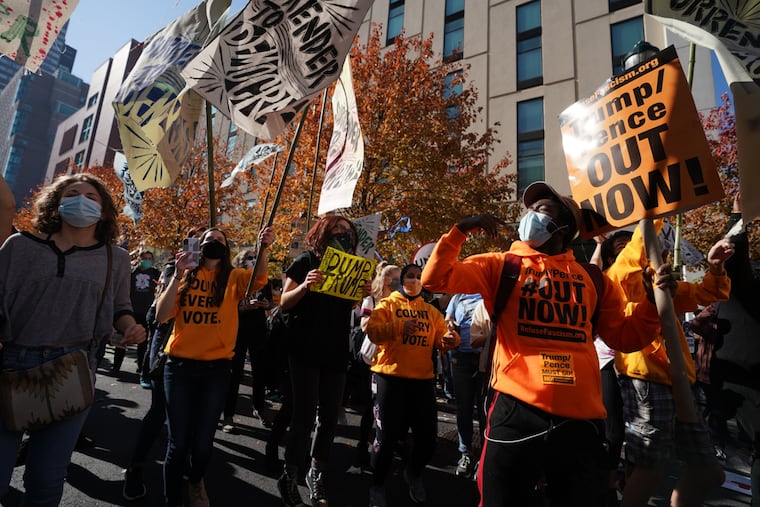Pennsylvania looks like it’s going to be really, really close
It’s looking like things will remain extremely close to the end in Pennsylvania, whoever wins.

Much of the world’s attention — and frustration, anxiety, and confusion — has been on the days-long process of counting votes in Pennsylvania. But the focus on the slow count in some ways obscures the real reason we don’t know who won yet.
It’s not just — or even necessarily — about the speed of counting votes. It’s about how close they are.
Consider, for example, how races can be called almost immediately in “safe” states. The Associated Press, The Inquirer’s source for race calls, declared Joe Biden the winner in California right after polls closed. That’s no shock, of course, but the point is it didn’t require a lot of votes to be counted. (In fact, as of Friday evening, the AP estimated California had counted about 78% of its votes, compared with 97% in Pennsylvania.)
So it’s not just about how many votes are counted and how quickly. It’s about the margins.
And in Pennsylvania, it’s looking like things will remain extremely close to the end, whoever wins.
Friday evening, three days after polls closed on Election Day, Biden had about 20,000 more counted votes than President Donald Trump. He was ahead by 0.3% of the counted 6.7 million votes.
Let’s do some back-of-the-envelope math just to get a sense of how close this race can be.
This is going to be a nail-biter
As of Friday evening, there were 6,705,557 total votes counted for president, according to unofficial results from the AP: Biden had received 3,324,096 (49.57%), Trump had received 3,304,471 (49.28%), and Libertarian Jo Jorgensen had received 76,990 (1.15%).
Since Biden’s in the lead, let’s see what would happen if things actually skewed even more in his favor, just to see how close the numbers could still end up being.
So let’s say there are 200,000 more votes that will be counted in the end — even more than the 180,000 or so the AP is projecting. And let’s say Biden wins a full 80% of the remaining votes, and Trump wins the remaining 20%. (Biden has won about 76% of mail ballots counted so far.)
That would give:
3,324,096 already counted Biden votes + 160,000 more = 3,484,096 total Biden votes
3,304,471 already counted Trump votes + 40,000 more = 3,344,471 total Trump votes
Biden would end up with 139,625 more votes than Trump. On the one hand, that’s a lot more than the 44,000 that Trump won Pennsylvania by in 2016. On the other, it would be a two-party margin of only 2 percentage points, because Biden would win 51% of the two-party vote and Trump would win 49%.
Of course, those are just hypothetical numbers. We don’t know what the actual vote totals will be, but they’ll likely be closer than that.
Here’s why.
We don’t exactly know how many more votes are going to be counted
The 6.7 million votes counted so far make up the vast majority of the total. But we don’t quite know how many more votes there are to be counted, in part because most of the remaining ballots fall into one of four categories:
Mail ballots that arrived between 8 p.m. Tuesday and 5 p.m. Friday, which the Pennsylvania Supreme Court said should be counted this election but Republicans have appealed to the U.S. Supreme Court. We don’t know yet how many ballots are in this category, though it seems relatively small, and we don’t know whether they’ll be counted.
Ballots that have some sort of issue, including minor ones, which county elections officials have to review and decide whether to count. This happens every election and can include issues such as whether to accept ballots that voters placed in other counties’ drop boxes on Election Day and whether to accept a ballot where the voter put the right information on the wrong lines.
Provisional ballots, the backup paper ballots that were in particularly high demand this election because of voters who requested mail ballots and then showed up to vote in person. There could be more than 100,000 of these, but many of them may very well be rejected because voters’ mail ballots will already have been counted.
Overseas and military ballots, which by law can arrive up to one week after Election Day. We don’t know how many of these ballots there are because they’re still allowed to come in.
Meanwhile, there’s a whirlwind of litigation surrounding Pennsylvania’s mail ballots, and we just don’t know how that will play out. Some of those legal challenges could affect the number of ballots — and which ones — accepted and counted.
Whatever happens, it’s going to be close to the end.